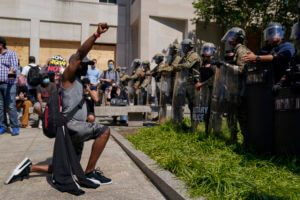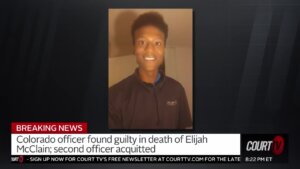By GENE JOHNSON Associated Press
SEATTLE (AP) — Washington state is embarking on a massive experiment in police reform and accountability following the racial justice protests that erupted after George Floyd’s murder last year, as nearly a dozen laws took effect Sunday.
But two months after Gov. Jay Inslee signed the bills, law enforcement officials remain uncertain about what they require, leading to discrepancies around the state in how officers might respond — or not respond — to certain situations, including active crime scenes and mental health crises.

Demonstrators gather to protest the death of George Floyd, Wednesday, June 3, 2020, near the White House in Washington. Floyd died after being restrained by Minneapolis police officers. (AP Photo/Evan Vucci)
“The laws were written very poorly, and the combination of them all at the same time has led to there being conflicts in clarity and in what was intended versus what was written,” said Rafael Padilla, the police chief in Kent, a south Seattle suburb.
The laws constitute what is likely the nation’s most ambitious police reform legislation. Supporters said they would help undo racial inequity in the justice system — “a mandate from the people to stop cops from violating our rights and killing people,” said Sakara Remmu, of the Washington Black Lives Matter Alliance.
Rep. Jesse Johnson, the Federal Way Democrat who sponsored bills on police tactics and use of force, acknowledged some clarifications are necessary — but said that’s not uncommon.
“We have to create new policies, because what we were doing before was not working,” Johnson said. “A lot of the pushback we’re getting is because it’s a paradigm shift.”
The measures ban chokeholds, neck restraints and no-knock warrants. They require officers to intervene when a colleague engages in excessive force and to report misconduct by other officers; make it easier to decertify officers; and create a new state agency to investigate police use of deadly force.
They restrict when officers can engage in car chases, make it easier to sue individual officers, and require police to exhaust appropriate de-escalation tactics.
Law enforcement officials have embraced some of the changes and said they share the lawmakers’ goals. But uncertainty about how to comply, combined with a greater possibility of being decertified or held liable, puts officers in a tough position, they say.
“The policing reforms may have the positive impact of reducing the number of violent interactions between law enforcement and the public,” said Steve Strachan, executive director of the Washington Association of Sheriffs and Police Chiefs. “However … we are deeply concerned that some policing reforms may have unintended outcomes that result in increased levels of confusion, frustration, victimization, and increased crime within our communities.”
For example, a restriction on military-grade weaponry would inadvertently ban the shotguns police use to fire beanbag rounds.
Johnson said the context makes clear the intent was to embrace, not ban, less-lethal weapons. He expected the state attorney general to clarify that until the Legislature can fix the wording next year.
But in the meantime, some departments, including Spokane police and the King County Sheriff’s Office, have hung up their beanbag weapons.
Even more significant is a change in when officers can use “physical force” — a term that isn’t defined in the new law, but which is typically interpreted to mean force as minor as handcuffing someone.
Historically, police have been authorized to use force to briefly detain someone if they have reasonable suspicion — a commonsense notion, based on specific facts, that someone might be involved in a crime.

Police officers deploy to disperse protesters in the Target parking lot near the Minneapolis 3rd Police Precinct, following a rally for George Floyd on Tuesday, May 26, 2020, in Minneapolis. Four Minneapolis officers involved in the arrest of Floyd, a black man who died in police custody, were fired Tuesday, hours after a bystander’s video showed an officer kneeling on the handcuffed man’s neck, even after he pleaded that he could not breathe and stopped moving. (Richard Tsong-Taatarii/Star Tribune via AP)
But under one of the new laws, police now need probable cause — a higher standard, based on evidence that the person committed the crime — before they use force. They can also use force if there’s an imminent threat of injury.
The higher standard is designed to keep police from using force against the wrong person, Johnson said.
But it also means police might sometimes have to let the bad guy go.
If officers show up at a burglary, for example, and they see someone matching the description of the suspect — but don’t have confirmation it’s the same person — they can ask that person to stop. If the person leaves, officers can’t use force to detain them while figuring out if they have the right suspect, they say.
The Criminal Justice Training Commission, which operates the state’s police academy, has had to modify its teaching to stress the importance of identifying probable cause.
“There is nobody else in the country having to do this,” said instructor Ken Westphal. “We have always worked in reasonable suspicion. Now, those force options aren’t there unless you have probable cause.”
But even that approach is not universal. Some departments, including Kent, say they will arrest violent suspects for obstruction if they flee, even if they don’t yet have probable cause for the underlying crime.
“I’m not letting violent felons take off,” Padilla said.
Other departments, including the King County Sheriff’s Office, won’t arrest people in such circumstances. Obstruction is sometimes considered a frivolous charge, filed when officers lack evidence of other crimes, and it’s unclear prosecutors will pursue it.
Similar concerns abound regarding mental health calls. Police often respond to people in crisis who are not committing crimes. Under existing law, a “designated crisis responder” can order the person to be involuntarily detained for psychiatric care, but the advocacy group Disability Rights Washington says police are increasingly refusing to show up.
That’s because officers aren’t sure they still have the authority to use force to detain or transport those subjects, absent imminent harm or probable cause, officials say. Further, police are now required to exhaust appropriate de-escalation tactics; that can include simply leaving the scene.
These laws are taking effect as police have left the state or the profession in droves. Seattle is down hundreds of officers following clashes with protesters, criticism and talk of “defunding” last year. The Kent Police Department is losing 21 of its 70 uniformed patrol officers this year, Padilla said.
Given limited resources, departments must decide whether it’s worth responding to such noncriminal mental health calls when officers might only leave anyway, some law enforcement executives say.
Advocates of people with mental illness have said some departments are “dangerously misinterpreting” the law and that nothing has overruled their ability to assist on mental health calls.
Sgt. Tim Meyer, a spokesman for the King County Sheriff’s Office, noted responding to new laws or court rulings is nothing new for law enforcement.
“We’re going to adapt and continue to serve the community,” Meyer said.
































